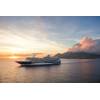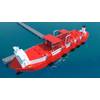Concordia Damen Tug for Walsh
Dutch shipbuilding major Damen Shipyards Group said that it has signed a contract with London construction services provider S. Walsh & Sons (Walsh) for a CS2010 pusher tug from Concordia Damen.
The pusher will be available for quick delivery in summer this year as a result of Concordia Damen’s practice of building stock hulls, the shipbuilder said.
The CS 2010 will join the growing Walsh marine fleet operating on the River Thames in the UK – including the Damen Multi Cat 1908 delivered in 2019. The new vessel will push barges on the river, transporting huge volumes of bulk freight in and out of London.
On delivery it will go straight into action, playing a key role in moving more than a million tonnes of spoil and materials for London’s Tideway project – a major infrastructure scheme to build a 25km ‘supersewer’ under the Thames that will have a massive positive environmental impact on the river and its surrounds.
The CS 2010 is a perfect fit for the task at hand. Concordia Damen has designed the vessel for operations on inland waterways and it therefore connects naturally to inland shipping barges. Furthermore, as a solution for operations in busy waterways such as the Thames, the vessel features ‘azimuthing’ thrusters for high levels of maneuverability.
Further adding to safe operations, the CS 2010 wheelhouse is fitted to a column that can be raised or lowered as required.
Damen sales manager Frederik van der Linde said, “I’m very happy that Damen can provide a solution to S Walsh & Sons that fits their needs. By working closely with Walsh and the team of Concordia Damen we now can look forward to seeing this pusher tug in operation on the Thames.”
Managing director for S Walsh & Sons Joe Gifford said, “This new pusher tug will be the latest addition to our expanding marine fleet on the River Thames. It will provide us with unmatched capability and versatility to meet the needs of complex infrastructure projects such as Tideway, with more capacity to shift large volumes of bulk materials in to and out of the capital by the most sustainable means possible.”
Related News





